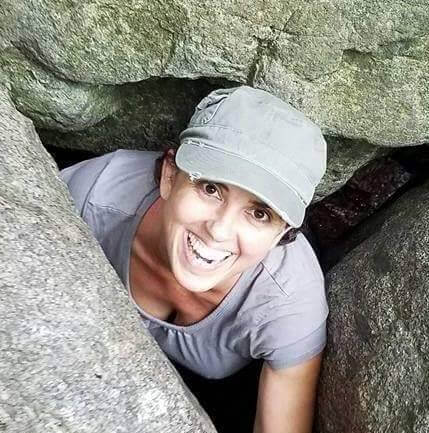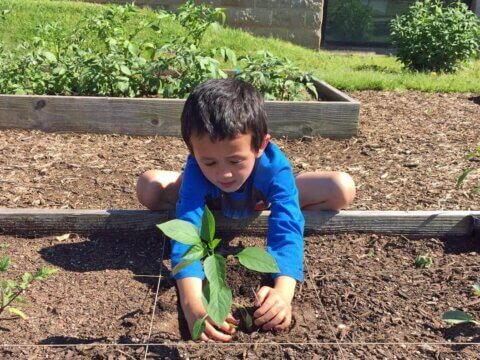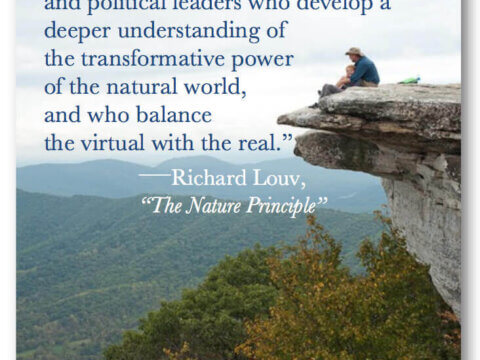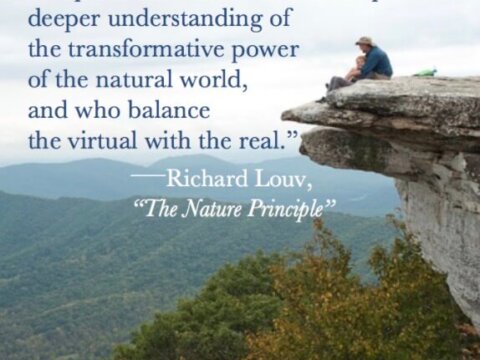Libraries and parks: A nature-smart partnership
At the San Pedro Branch Library in San Antonio, Texas, children and their grown-ups are packed into the small library space, hanging on to a local environmental educator’s every word. The conversation in the room is energetic. A child asks about the endangered golden-cheeked warbler and why it needs a specific tree. A mother and her 10-year-old daughter appoint themselves Ranger David’s assistants, helping him hand out leaf samples, coloring sheets and crayons for leaf rubbing. “I’m a real tree hugger now,” says the mom, laughing.
In cities across the U.S., these moments of learning and community connection are the result of strong partnerships between public libraries and parks departments.
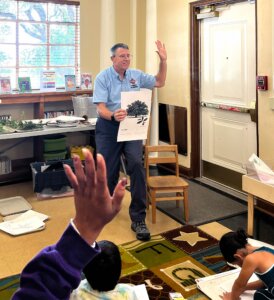
Ranger David, an education coordinator from San Antonio Parks and Recreation Natural Areas, talks to children and parents about Texas trees and wildlife at a local library. Photo courtesy of San Antonio Public Library.
“Our goal is not only to bring people to natural areas but also to bring natural areas to the people,” says Wendy Leonard, assistant manager for San Antonio Parks and Recreation Natural Areas. “Libraries are a doable and synergistic partnership.”
Cresencia Huff, coordinator of Children’s Services at San Antonio Public Library, agrees. “Observing how the community engages with each other and our local environment energizes me,” says Huff. The library’s partnership with the parks department has been an incredible asset, increasing nature-based opportunities and giving San Antonio Public Library a model for building additional partnerships with other nature-based organizations.
A library that plays an essential role in helping communities connect to nature is often referred to as a “Nature-Smart Library.”
“Every city department has a role to play in supporting children and families,” says Melanie Robinson, program manager for Connecting Children to Nature at the National League of Cities. “Children thrive with regular, daily access to nature and the outdoors, so cities are looking for ways to bring nature’s benefits to where children are. Libraries are responding to that call.”
“Libraries, like schools and day care centers, are trusted and safe community resources. They exist in every neighborhood and serve as community hubs,” adds Robinson.
Connecting families to nature in Texas

Texas Children in Nature Network collaborates with libraries across the state to provide families with free access to state parks. Graphic courtesy of Texas Children in Nature Network.
Sarah Coles, executive director of the Texas Children in Nature Network, says libraries help organizations reach families that otherwise wouldn’t have access to nature-based resources. “Families trust programs that libraries put on. We can reach people at a library who may not have access to, say, a nature center,” Coles explains.
In addition to offering in-house nature experiences, libraries are encouraging more people to explore the outdoors. By providing lendable “Library Explorer Adventure Packs,” the Texas Children in Nature Network is helping new families visit Texas parks and natural areas. The backpacks include nature books, tools for safe outdoor exploration and free passes to places such as state parks, local zoos and nature centers.
“For many of our families, going out to natural areas can be cost prohibitive. So the backpack is taking that cost away,” says Coles. “At libraries, you can get books for free. Now, you are also starting to get nature experiences that same way.”
By the end of 2024, Coles says they will have over 200 backpacks across libraries in Texas, specifically those in areas with traditionally limited resources, such as small community libraries in the Rio Grande Valley and urban libraries in Dallas with less access to nature.
Advancing access in California
As in Texas, equity and access are at the heart of what drives many libraries’ nature-smart partnerships. San Francisco, California, is another prime example.
“We have very low populations of Brown and Black communities accessing our libraries and parks,” says Christy Estrovitz, Assistant Chief of Branches for San Francisco Public Library. To improve access to these resources, the library aims to reach people in their own communities by bringing the library to neighborhood parks through initiatives like their bookmobile.
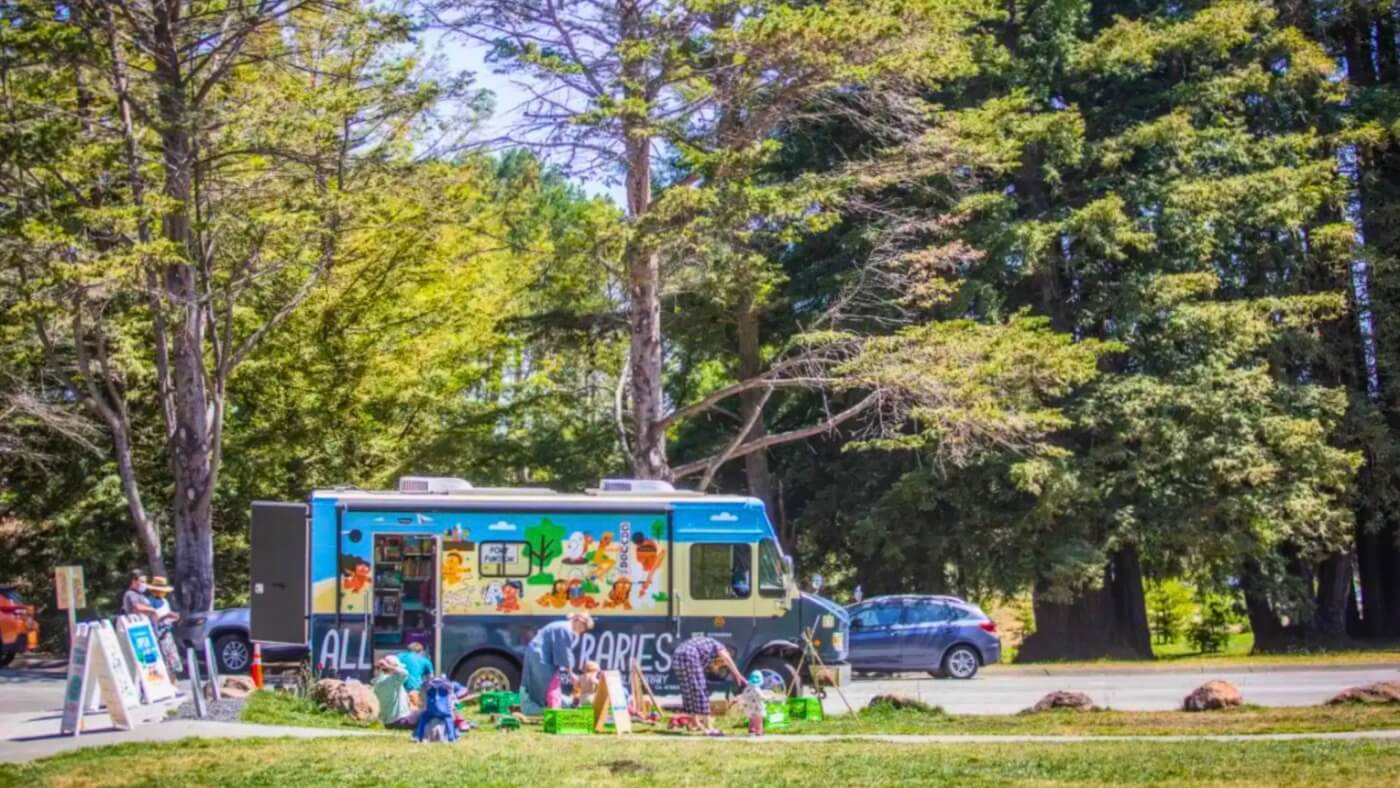
The San Francisco Public Library YouthMobile engages children and family in local parks. Photo courtesy of San Francisco Children & Nature Collaborative (SF Children & Nature).
“From the park department’s perspective, the library provides a community benefit by bringing programming directly to neighborhood parks where people live — they provide storytime with a dose of Vitamin N,” says Maria Durana, director of the San Francisco Children & Nature Collaborative within San Francisco Recreation and Parks Department.
The library’s branches also offer exciting nature programs, events with live animals, free shuttle services to parks, walking field trips and other outdoor activities. “The library supports communities getting out to our national parks through the shuttle program. Our partnership with the National Park Service supports this equity-driven approach,” says Estrovitz.
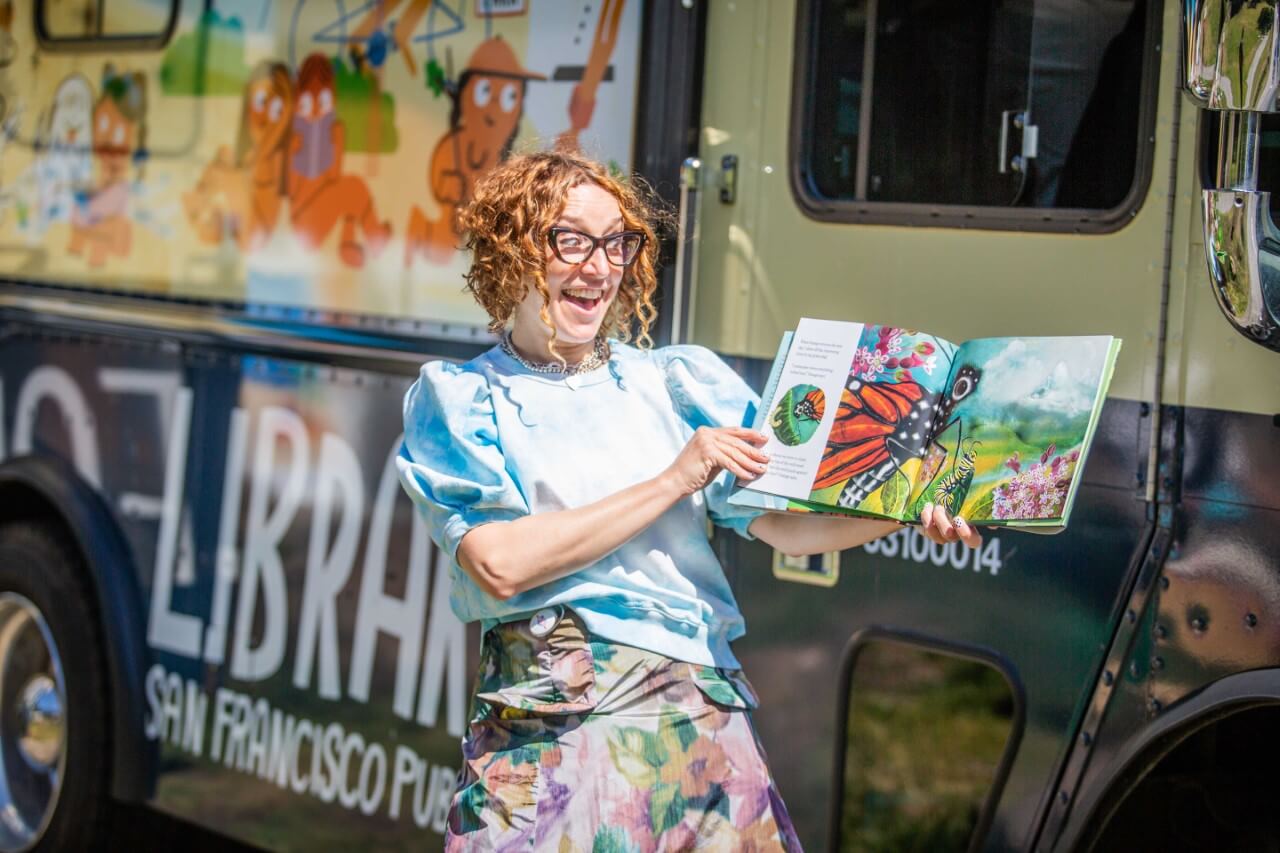
The San Francisco Public Library YouthMobile brings a high-energy storytime to local parks. Photo courtesy of SF Children & Nature.
Jen Woo, family engagement coordinator for San Francisco Public Library, oversees programming for children ages 6 to 12 years old across the city. She says that while the ambitions are big, they often start small. She has grown programs by starting with a simple pilot then replicating what was successful and building on existing relationships.
Partnering on nature passports in Utah
In Utah, the statewide “Every Kid Outdoors” initiative legislates that every child should have the opportunity to participate in free or low-cost outdoor activities. As part of this initiative, a nature passport program was launched, offering free passports at public libraries that outline the 10 outdoor activities all children in Utah should have the opportunity to experience. Partnerships between libraries and the Utah Department of Natural Resources have been key in implementing this program.
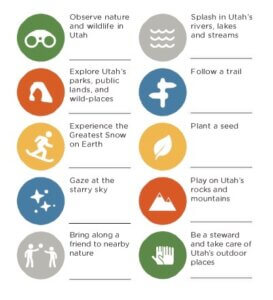
Utah law says children should have the opportunity to access these ten outdoor activities. Graphic courtesy of Utah Division of Outdoor Recreation.
As a first step to integrating libraries into the passport program, the Utah Department of Natural Resources’ Division of Outdoor Recreation brought cities and library branches together for a stakeholder meeting. At the meeting, librarians reported that they lacked the staff capacity to execute nature-based programs supporting the passport activities. In response, the Division connected Utah’s libraries with newly hired city park rangers who could focus on interpretation and education.
Now, park rangers and librarians coordinate nature programming, training and other activities to offer some of the outdoor activities named in the Every Kid Outdoors initiative. “That relationship [between park rangers and libraries] is built and now it’s running. It’s a sustained relationship,” reports India Nielsen Barfuss, the Division’s deputy director of operations.
Collaborating for nature-connection success
Nielsen Barfuss and others working on Nature-Smart Library programs across the country all acknowledge that building sustainable partnerships takes time, patience and a lot of relationship building. They also all point to the shared goals, natural alliances and ease of collaboration between parks and libraries. Though this type of collaboration may not be written into policy or even job descriptions, partners find ways to make the relationships sustainable.
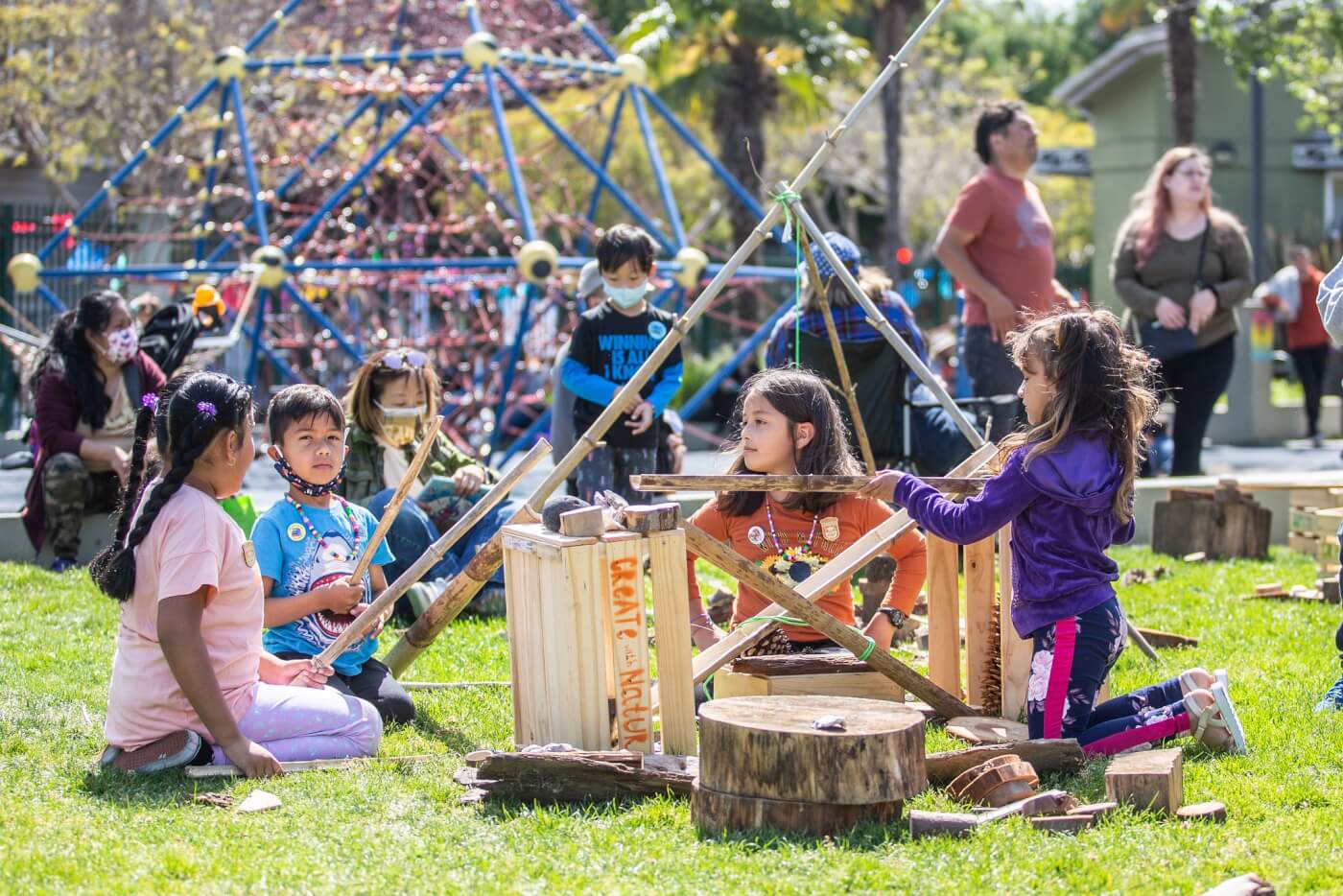
San Francisco Public Library hosts an annual Día de los Niños, Día de los Libros event that brings families to a local park for nature-based activities, including yoga, nature play elements, a bookmobile, Roving Rangers and more. Photo courtesy of SF Children & Nature.
Communication and collaboration between cities have also been helpful in understanding successful models of Nature-Smart Libraries across the country. Cities participating in the Cities Connecting Children to Nature (CCCN) initiative reported that engaging in CCCN’s national peer learning network, along with site visits and conferences, allowed them to better envision and get excited about the possibilities for nature connection within their own library systems.
CCCN has evolved into the Nature Everywhere Communities initiative, a partnership between Children & Nature Network, the National League of Cities and Kaboom!. The Nature Everywhere Community partners are now evaluating promising practices in Nature-Smart Libraries across the country and plan to create resources to further support new communities in utilizing libraries as nature connectors.
Promising practices for integrating nature into libraries include:
- Nature activities and programming at libraries, parks or partner sites that focus on connecting children and families to nature. For example, holding programs in outdoor spaces, including nature-based curriculum in activities, installing story walks or hosting family nature clubs.
- Lending libraries that provide patrons with access to free or low-cost items to explore the natural world. Items can include nature backpacks, park passes, nature-related books, seed libraries and book exchanges in parks.
- Outdoor space activation to maximize outdoor spaces or build connections with local parks — gardens, outdoor reading areas and wildlife features can be enhanced for library access.
- Technology and participatory science programs that use tools such as iPads or apps to encourage patrons to participate in scientific activities, nature identification or online research projects.
Implementing these promising practices can be made easier through partnerships. From San Antonio to San Francisco, parks and library staff report that their partnership has become an integral part of how they do business. They intentionally seek out each other’s staff, partner on executing strategies and events, and have institutionalized their partnership by including it in their annual performance goals.
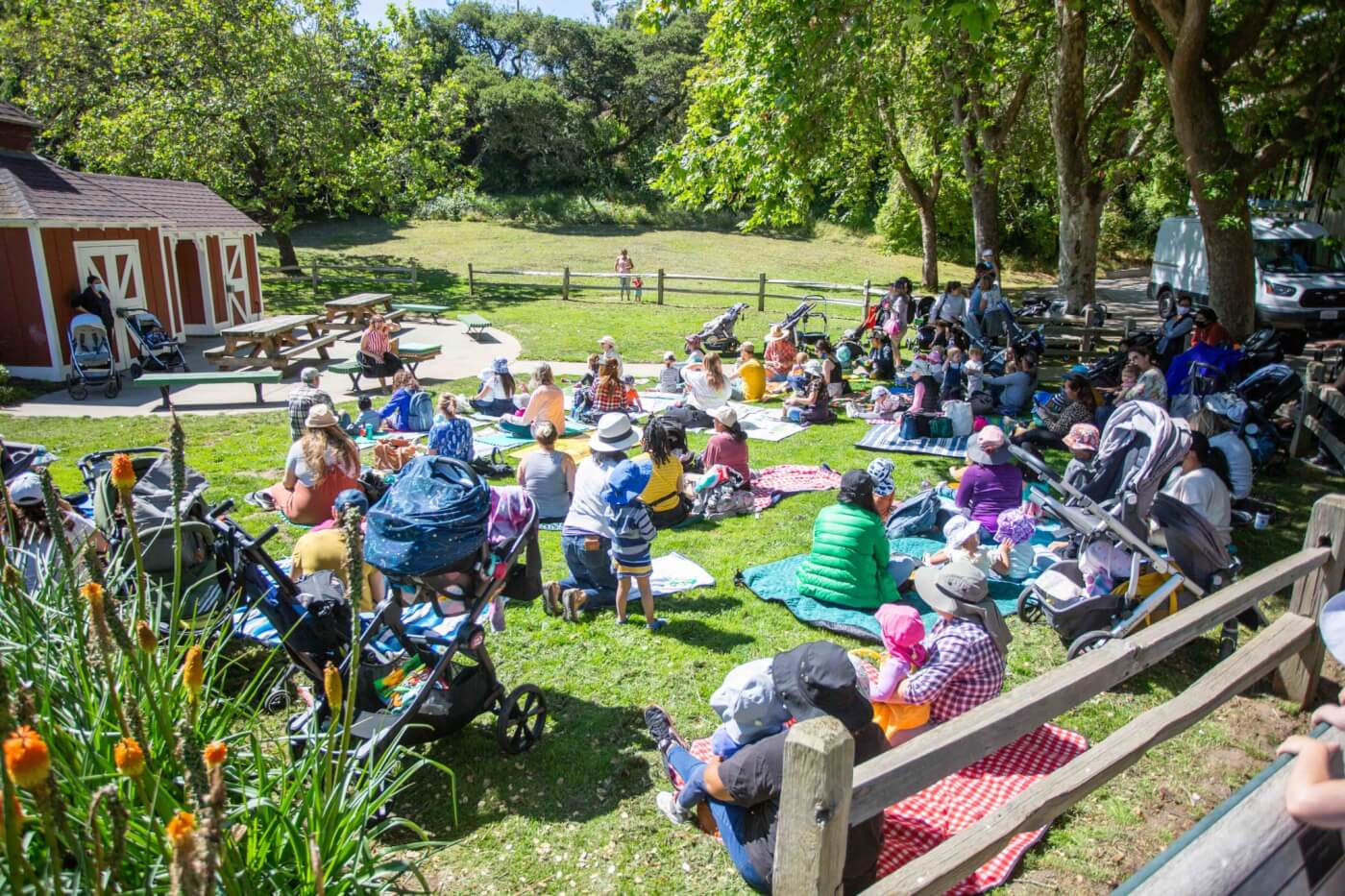
San Francisco’s YouthMobile draws a crowd of families together in a local park for storytime. Photo courtesy of SF Children & Nature.
“People want kids to thrive and grow up into happy, well-functioning adults,” says Nielsen Barfuss. “When you can make that connection for them — that these partnerships and programs contribute to overall health and community well-being — then everything else falls into place.”
Libraries as nature connectors, a strategy overview
Public libraries as nature connectors, a webinar recording
The essential role of libraries in creating nature-rich communities, a Finding Nature News story
Thinking outside of the stacks: The growth of Nature-Smart Libraries, a Finding Nature News story
Let the story be your guide, a Finding Nature News story
-
Network News
POLICY UPDATE: Policy and advocacy for the children and nature movement
-
Voices
Binoculars, bald eagles and my journey as a Black birder
-
Richard Louv
THE WONDER BOWL: Ten Spring and Summer Nature Activities for Kids and Adults
-
Network News
Minneapolis Spotlight: The promise and possibilities of parks for youth
-
Voices
Why nature is my motherhood ally



